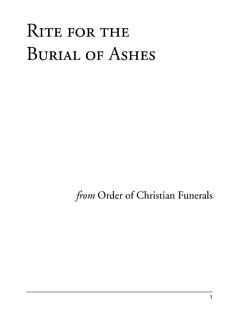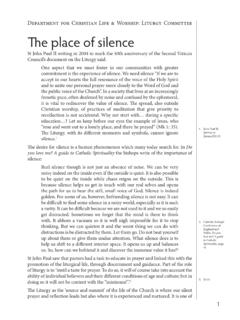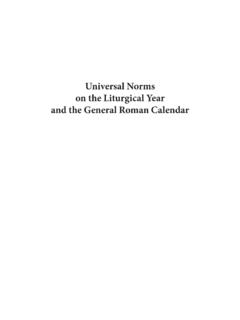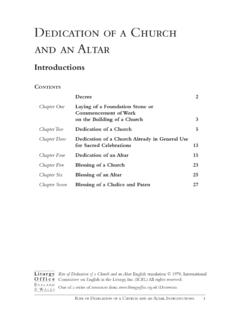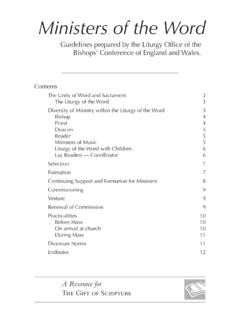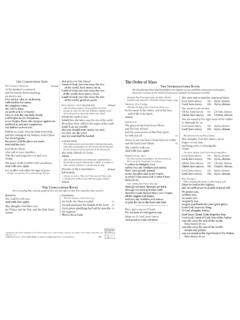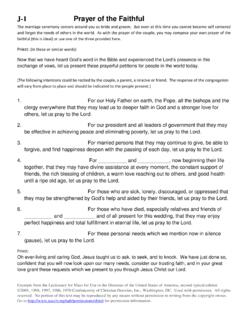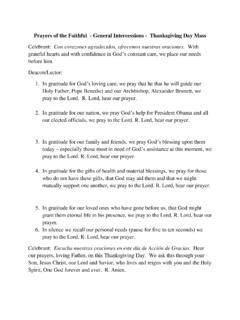Transcription of Reflections on Good Practice - Liturgy Office
1 Department for Christian Life and Worship Liturgy Committee The Prayer of the FaithfulReflections on good PracticeStructureThe intentions are not mini-prayers, addressed to , the intentions are biddings, invitations by which the assembly is asked to pray for certain people and things. (Michael Kwatera, Preparing the General Intercessions)As both General Instruction of the Roman Missal and Celebrating the Mass state, the intentions are directed to the congregation. They seek the consideration and prayer of all, more than being the deacon s /reader s personal prayers to God, shared with others. The celebrant begins the prayers, with an introduction directed to the people. The deacon or reader announces the intercessions. So, an intercession should begin Let us pray or or.
2 The celebrant concludes the intercessions with a prayer, commonly to the the responses Lord hear us; Lord graciously hear us and Lord, your mercy; Hear our Prayer are frequently used at the end of prayers, it is acceptable to use other endings, especially if the chosen phrase highlights an important aspect of the particular general intercessions are often the junction where poor theology, listless prayer and vacant language gather. (Richard Mazziota, We Pray to the Lord)At every celebration of the life of the Church, the structure given for the Prayer of the faithful ensures that the congregation looks beyond its boundaries to the wider Church and the world. From time to time it is appropriate to pray for the Head of State (in Great Britain, the Queen) and for the welfare of the armed on Sundays or special days with a specific theme or focus, it is important to acknowl-edge that the Prayer of the faithful should not be reduced to the theme of the day, but that the theme may be like a prism through which the intentions of the Church and the world are use of published books of intercessions may be helpful in giving suggestions.
3 However, the need for the intercessions, to reflect the current concerns of the community, the world and the universal Church means that adaptation should always be must be taken not to allow the Prayer of the faithful to become too predictable by means of recurring phrases from one week to the speaking, the Prayer of the faithful is not the appropriate time to announce informa-tion that is not already known, or that is likely to provoke shock to the assembly (eg. a notable death in the community, or a significant world event with which people are not familiar). In the case of a notable death or significant world event, it is appropriate to announce this earlier in the Mass, after which the Prayer of the faithful can support the community s prayer for the particular it is an established custom in some places to include the names of the sick and house-bound of the parish in the Prayer of the faithful , such an approach can be exclusive or exhaustive.
4 If however, the prayer is for all those who are sick within this community and beyond there is no distinction, and the purpose of the community s vision of the world being broadened is better achieved. To hold before the worshipping community members of the parish who are sick and house-bound also has its place, there is a prayer for the dead, it is fitting that this should be after the prayers for the intentions are a way of declaring publicly that what we most need we are incapable of acquiring for ourselves . (Eleanor Bernstein, Enabling Intercession)After appropriate training in the structure and purpose of the Prayer of the faithful , the interces-sions may be composed by the celebrant, or a deacon, or a member of the faithful . It is worth noting that the priest (as a figure of unity in a parish community) or the deacon (as a minister of charity within the community) are better placed than others to know the current needs of the parish.
5 So, in the event of the intercessions being composed by a member of the faithful , it is right that consultation should be made with the intercessions of the Prayer of the faithful are appropriately announced by the Deacon. First-ly, there is a parallel with the mercy of God that we seek in the Penitential Rite (the intentions for which may also be announced by a Deacon). Secondly, the deacon is the minister of charity who, by tradition, knows the needs of the people so that he might announce is preferable that the intercessions for a particular occasion should be prepared before the Mass begins. The intercessions being general, and encompassing the needs of the Church and the world, should encourage those present to assent to the prayers announced. If however it is deemed suitable to allow for extemporaneous (open) prayer, then it is better to take this approach from the outset, rather than as an addition to announced, prepared intercessions.
6 Other considerationsThe number of intercessions for any given occasion should not vary according to how many people are available to read. Between four and six intercessions is an appropriate should be borne in mind when selecting people to announce the intercessions (if a deacon is not present) that there is a greater potential for measured reading where the same person reads two or three intercession. This can, therefore, be preferable to six people for six should not be considered a time at which to thank people for what they have done, even on special occasions that warrant thanks. The intercessions are prayers in which we ask God for what we need and, if appropriate, thank God for his goodness to his care should be taken when preparing to read the Prayer of the faithful .
7 Similar preparation must be given to words and phrases in the prayer as to the preparation of a Scripture passage for proclamation in the resource was prepared by the Liturgy Committee of the Department for Christian Life and Worship 2008 Catholic Bishops Conference of England and Wales. It can be downloaded from Instruction of the Roman Missal69. In the Prayer of the faithful , the people respond in a certain way to the word of God which they have welcomed in faith and, exercising the Office of their baptismal priesthood, offer prayers to God for the salvation of all. It is fitting that such a prayer be included, as a rule, in Masses celebrated with a congregation, so that petitions will be offered for the holy Church, for civil authorities, for those weighed down by various needs, for all men and women, and for the salvation of the whole world.
8 70. As a rule, the series of intentions is to be: a. for the needs of the Church; b. for public authorities and the salvation of the whole world; c. for those burdened by any kind of difficulty; d. for the local community. Nevertheless, in a particular celebration, such as Confirma-tion, Marriage, or a Funeral, the series of intentions may re-flect more closely the particular occasion. 71. It is for the priest celebrant to direct this prayer from the chair. He himself begins it with a brief introduction, by which he invites the faithful to pray, and likewise he concludes it with a prayer. The intentions announced should be sober, be com-posed freely but prudently, and be succinct, and they should express the prayer of the entire community. The intentions are announced from the ambo or from an-other suitable place, by the deacon or by a cantor, a lector, or one of the lay faithful .
9 The people, however, stand and give expression to their prayer either by an invocation said together after each inten-tion or by praying in silence. Celebrating the Mass171. Enlightened and moved by God s word, the assembly exercises its priestly function by interceding for all humanity. Because the joy and hope, the struggle and anguish of the people of this age and especially of the poor and those suffering in any way are the joy and hope, the struggle and anguish of Christ s disciples, the Church prays not just for its own needs but for the salvation of the world, for civil authorities, for those oppressed by any burden, and for the local community, particularly those who are sick or who have died. 172. Thus, even though the intercessions may be quite concrete or particular in content, they should always look beyond the concerns of the local assembly to the needs of the whole Church and of the wider world.
10 They are a sign of the com-munion of the particular assembly with all other assemblies and with the universal The priest celebrant directs the prayer from the chair. He briefly invites the people to pray, and at the end he draws their intercessions together in a brief concluding prayer with a short doxology. The intentions are proposed by a deacon, a cantor, reader, other minister, or members of the assembly at the ambo or another suitable place. After each intention, the faithful respond by silent prayer or a common response or both. They affirm the concluding prayer of the priest with their Amen. It is appropriate for the Prayer of the faithful to be in- cluded in all Masses. Both the priest s introduction and the proposed inten- tions are addressed to the assembly, not to God.

